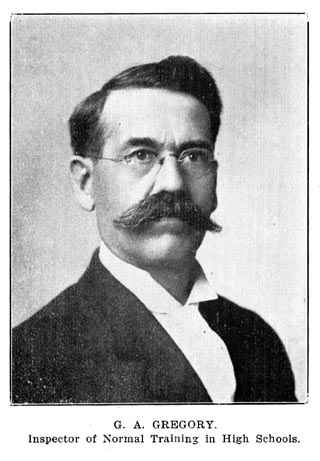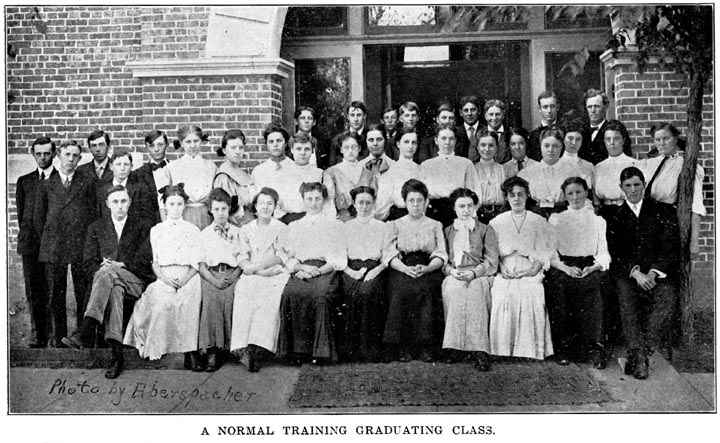

NEGenWeb
Project
Resource Center
Schools
|
16 |
|
INTRODUCTION.
Since the issuance of the first course of study, by this department, for normal training in high schools, December 3, 1907, the work has so developed that a second issue is now necessary.
Every pupil in normal training classes should be supplied with a copy of the course of study and should become familiar with it. He will find it helpful as a guide in directing his work and as a means of information on matters of importance relative to preparation and certification as a teacher. Each teacher who is in any way responsible for the normal training work should have a copy of the course of study and should know clearly all its provisions.
The cases in our experience where normal training students learn at the time of graduation that they have failed to comply with some of the requirements of normal training and hence are at a disadvantage in securing their teacher's certificates, come largely from failure on the part of such students to become acquainted at the proper time with the normal training requirements. Often they have been misdirected by their teachers. For this reason, we urge that each normal training student and instructor at the beginning of the year become at once familiar with all the provisions concerned in the normal training course.
At the time of the first edition of the course of study, normal training in high schools was in the experimental stage. Considerable space therefore was devoted to discussion of the value of this work and its relation to the teaching force of the state. The experimental stage has passed. The excellent results attained by actual trial of this method of helping to prepare more and better teachers for rural schools attest the wisdom of those who evolved the plan. The hundreds of such teachers now doing successful work in our schools are evidence of the fact that normal training in high schools in Nebraska has helped in a large way to solve the problem of a greater supply of better trained teachers for the rural schools.
Since the course of study has given such general satisfaction very little change is made in the outline for this edition. The course is intended to be suggestive as well as directive. After meeting all required conditions, each superintendent and director in charge will make such use of the course of study as is found most helpful with local conditions.
That the normal training work Is meeting with the approval of school men and women, of patrons, and of high school pupils, is shown
4


|
|
17 |
by the large increase in enrollment in classes and the increase in the number of schools giving the work. From a dozen schools giving the work previous to 1907 when the state appropriation was made available, the work has grown to sixty-nine schools in 1907-8, ninety-eight In 1908-9, and one hundred ten in 1909-10. The general expression of satisfaction from county superintendents, school boards and patrons with the quality of work done by graduates of normal training high schools is our strongest evidence of the wisdom of continuing to extend the work to all communities of the state.
At the last session of our legislature the value of this work to the state and its bearing upon the development of the highest type of citizenship through education was fully discussed, after which the appropriation was increased from $50,000 to $75,000, thus indicating the views of men who give careful attention to the real needs of the people.
The Interest in and the enthusiasm for the work so general throughout the state comes from the real test as shown by the results already attained even in the short time that normal training has been operative. Our normal schools, filled to their capacity, are yet unable to supply a sufficient number of teachers for the grades of city and town schools. This leaves the high school our greatest source of supply for teachers for rural schools. Our rural schools must continue to be supplied with teachers, very largely, by the high schools. Whether trained or not for it, high school graduates begin their work of teaching, almost without exception, in the rural schools. It is this condition which makes the normal training course in high schools of so great importance to the upbuilding of the rural school which has been and will continue to be one of the greatest factors in education in this country.
Reports on file in this office from county and city superintendents show that a larger number of graduates from normal training high schools are now teaching in the rural schools than there is of those holding elementary certificates from all the stale and private schools combined.
This shows the immediate value and effectiveness of the high school normal training. Many of our most capable students are made quickly available for the rural schools where they are most needed. Only about 600 of these new teaching in rural schools in Nebraska have had no normal training. Should we not expect an improved condition in rural schools with se many teachers in the ranks who have had normal training? Reports of county superintendents indicate that the quality of work now done is superior to that of a few years ago. Two thousand two hundred seven have graduated from the normal training course in our high schools in the past three years and a sufficient number of these to make a change for the better are in active work.
|
18 |
|
Incidental good results are reported by city superintendents. The large majority agree that: Normal training has improved the discipline in the high school; given higher ideals to the school; helped normal pupils into a better attitude toward their studies, as well as toward discipline; and brought the community into closer and more helpful relation to the schools. Each of these points will appeal at once to the intelligent patron of our public schools as being very desirable for forming the atmosphere and environment that will be most helpful in developing true manhood and womanhood.
From the good results already apparent normal training in high. schools is amply justifying the small additional expenditure made for it by the state and community.
The purpose of a state system of education is to place within the reach of every child the proper facilities for a common school education. Our city and town schools of the better class have provided modern facilities for the education of the children of their own communities. Rural schools, outside of the exceptional districts, have failed to keep pace with progress in other lines of development. Modern school principles and equipment are important factors, but the rural school cannot be what it should be unless it has well trained teachers. The grade of work done in the rural schools depends upon the teachers more than upon any other one factor.
County superintendents report that the normal trained teachers from high schools have very much improved the grade of work done in rural schools. We are at the beginning of a solution of the problem. Teachers for rural schools should not only have a general training for teaching, but should have an operative degree of special training for teaching in rural communities. This provision is being rapidly met by our best high schools in the introduction of courses in agriculture, domestic science and manual training, which enables a teacher educated in the normal training high school to make an effective application of educational principles and practice in his work in the rural community. The time is near when these courses of study will be a requirement in all institutions training teachers for rural communities.
The average teaching experience of a teacher in this state and throughout the country is three years. The greater number of teachers remaining in the service longer than this time get their first experience in the rural schools, and then pass on to graded or high school work. If our rural schools are to have trained teachers, we must not only train a large number but must continue to do this each year. Our cities and towns will continue to be partly provided with trained teachers from normal schools, colleges and universities, and by teachers who have had successful experience in rural school work. This drain upon the rural schools cannot be stopped. Our only remedy is to provide each year such a supply of properly trained teachers that the rural schools will not suffer materially because of it.
|
|
19 |
Before the establishment of our uniform state system of county certification, the enactment of the law requiring some degree of normal training for first and second grade county certificates, and the law providing for normal training high school courses, many rural schools were in charge of teachers who were eighth grade graduates from those schools; or what was sometimes better, --often worse,-- young people from neighboring towns with some more academic preparation but with no training and usually with little knowledge of or sympathy with the conditions of the country school, were certificated and put in charge of rural schools.
The free high school law together with the normal training requirements needed to secure a first or second grade certificate are bringing hundreds of our most capable young people from the rural schools into high schools, where many of them graduate from the normal training course. These become the best type of teacher possible for the rural school. They rank well in scholastic attainments with city youth and they understand and sympathize with rural conditions in a way that urban bred teachers cannot.
To normal training high schools, our rural population is looking for those well trained teachers who are of the type needed to inspire pupils with a desire for intellectual culture and t the same time keep them in sympathy with rural life. Here is the solution of the greatest social, civic, and economic problems of our state. Foster a better educational policy for our agricultural communities, give an education that is fitting, appropriate, and practical, an education that provides the right degree of general culture and that includes the elements of agriculture, domestic science, and manual training and we shall see not only the young people whose future is best directed thereby, remain on the farm, but remain there with that better training by which they will utilize the most advanced methods of husbandry, not only to the financial advantage of city and country, but with that degree of intellectual and spiritual attainment that will make them better citizens and of the optimistic class who learn to enjoy and utilize their environment for the best ends of life. This can be accomplished only by better and properly trained rural teachers. These must come largely from the farm through the normal training and agricultural high schools back to the country school.
E. C. BISHOP.
August 15, 1910.
Superintendent G. A. Gregory of Crete was appointed inspector of normal training in high schools in the fall of 1909 and assumed his duties December 1, 1909. Mr. Gregory was at the time of his appointment serving his tenth year as superintendent of the Crete city schools, where the work in normal training was so effective as to excite much favorable comment.
 |
 |
 |
 |
|
© 2003 for the NEGenWeb Project by Ted & Carole Miller |
|||